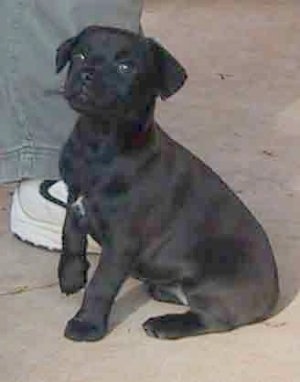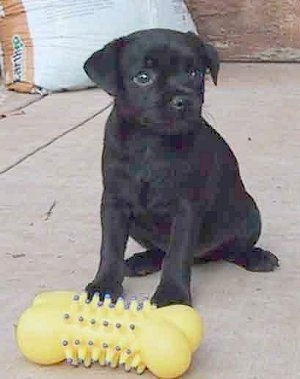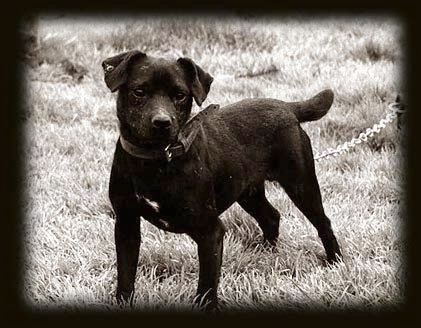Beau the Patterdale Terrier at 1 year old
The head of the Patterdale is strong and powerful, in balance with the size of the dog, and wedge or trapezoidal shaped when viewed from the front. The length of the skull and the muzzle are equal, or with the muzzle slightly shorter than the skull. Jowl and muzzle have good substance. The muzzle should be strong, never appearing snippy or weak. Strong, white teeth meet in a scissor or level bite. Teeth that are broken or incisors that are lost due to working are not to be penalized. The eyes are set squarely in the skull and fairly wide apart. As an earth-working terrier, it is important that the eyes not protrude or bulge. Eye color should be in harmony with the coat color, but never blue. The ears are triangular in shape, and small to moderate in size, folding tightly just above the skull. The tips point to the outside corner of the eye. The nose is black except in the liver-colored dogs, which have a red nose. The neck is clean, muscular and of moderate length, widening gradually from the nape and blending smoothly into the shoulders. The shoulder is long, sloping and well laid back. The forelegs are strong and straight, with good bone. The elbows are set close to the body but move freely. Pasterns are powerful and flexible. The body should be square or slightly longer than tall, measured from the point of the shoulder to the point of the buttocks, and from the withers to the ground. The back is of moderate length and level, blending into a muscular, slightly arched loin that has slight to moderate tuck up. The chest should be firm yet flexible, deep to the level of the elbow but moderate in width and oval in shape. Spanning is an important part of the judging process for Patterdale Terriers. They must be spanned to test for size, compression and flexibility. The Patterdale should be capable of being spanned directly behind the shoulders by an average sized man’s hands. When spanning, lift the front legs off the ground or table and gently squeeze the bottom of the chest to be certain that the chest will compress. The hindquarters are strong and muscular. Bone, angulation and musculature match that of the forequarters. The stifles are well bent and the hocks are well let down. When the dog is standing, the short, strong rear pasterns are perpendicular to the ground, and when viewed from the rear they are parallel to one another. The tail is set high but not carried over the back. If docked, only one-quarter to one-third should be removed, as sometimes the tail is the only means of pulling the dog out of a burrow. The tail should be strong but not overly thick. There is no preference between docked or natural. The coat may be smooth or broken. In both coat types, there should be a short, dense undercoat. Very little grooming is required to keep the coat healthy. Smooth: hair is coarse, dense and stiff, falling back in place when lifted. No wave is present. Broken: an intermediate coat, having longer guard hairs than the smooth coat. The guard hairs are coarse and wiry and may be wavy. A broken-coated dog may or may not have face furnishings which form a beard, moustache and eyebrows. Acceptable colors include black, red, liver, grizzle, black and tan, and bronze, either solid or with some white markings on chest and feet.
The Patterdale Terrier is a laid-back terrier, not as yappy as some other terriers. It enjoys "curling up at the heating duct" in the house. Although the Patterdale Terrier's small size could qualify him as a toy dog, his abilities and gameness deem him as a solid terrier; his determination and toughness demand his inclusion in the mastiff group. They are game and tough when hunting. Hunters often take three or four dogs with them on an outing. The Patterdale Terrier is a good watchdog. This is not a dog for the non-terrier fan or the faint-hearted. The Patterdale Terrier is a robust, independent hunter bred solely for functional services as a ratter and hunting companion. Its Bull Terrier bloodlines make it too fierce to work as a hunter with pack hounds. They are particularly hard and persistent. Many Foxhound owners would not thank you for attempting to bolt his fox with a hard-bitten Patterdale, for the dog is more likely to get hold and have a go, possibly kill the fox rather than allow him to bolt, thus spoiling the hunt with the hounds. It is an excellent digger, intently willing to encounter and attack any mammal that has gone to ground. The fells of the north country, with the protection afforded foxes in borrans, rock tip, mines and scree, created the need for a hard terrier able to scramble over the terrain and fearless enough to go to ground. The Patterdale filled, and still does, fill that need. The interest of local breeders ensures its survival. The breed is not easy to obedience train. The Patterdale should not be trusted with non-canine pets. Be sure to be this breed’s firm, confident, consistent pack leader to prevent behavior problems from developing. Not recommended for the average pet owner. They need to have their minds challenged along with plenty of mental and physical exercise. If they sense you are not as strong minded as they are, they will believe they are alpha and the humans will run into issues. Do not allow this dog to develop Small Dog Syndrome.
Height: about 12 inches (30 cm)
Weight: 11 - 13 pounds (5 - 6 kg)
--
The Patterdale Terrier is not recommended for apartment life. This breed is relatively inactive indoors provided it gets enough exercise during the day. The Patterdale can be kenneled with two or three other terriers, as long as he has enough work and hunting to keep him exercised and content. If bored and unexercised, he may pick fights with kennel mates.
This small-game hunter is a working dog and needs a lot of exercise. Your dog needs to be taken on a daily, brisk, long walk or jog. While out on the walk the dog must be made to heel beside or behind the person holding the lead, as in a dog's mind the leader leads the way, and that leader needs to be the human. Exercise and a hardy stock of prey are the recommended ways to satisfy his hunting cravings. They are inactive indoors but a bundle of energy outdoors. They love to run and will enjoy going hiking with you.
About 11-13 years.
About 3 to 6 puppies
Little grooming is required.
At one time, different strains of terrier existed in each isolated village in the north of England. Breeding to Kennel Club standards reduced this great variety, but some remote region's unrecognized breeds continued to flourish. The Patterdale is one of these breeds. Virtually unknown outside Great Britain, this breed is generally found in Great Britain's Lake District and in Yorkshire. The name Patterdale was chosen after the village in Cumbria, where the dogs were common. Used as a rat, fox and rabbit hunter, the Patterdale Terrier is not bred for appearance, but rather for its working ability. One breeder says that show conformation is so trivial that, were it the case, a dog could work better with two heads, "we would select immediately for that trait." The Patterdale was first brought to the USA in 1978. In the USA the dogs hunt anything with fur from woodchuck (groundhog), fox, raccoon and even badger. An American Patterdale suitably named "Rocky," a flyweight at 13 pounds, recently drew a 34-pound (16 kg) badger!
Tanzi the Patterdale Terrier as a puppy at 5 months old
Bippie the Patterdale Terrier
Pat the chocolate Patterdale Terrier puppy at 11 weeks old

Photo courtesy of MQH Patterdale Terrier Kennel

Patterdale puppy photo courtesy of MQH Patterdale Terrier Kennel

Patterdale puppy photo courtesy of MQH Patterdale Terrier Kennel

Photo courtesy of MQH Patterdale Terrier Kennel